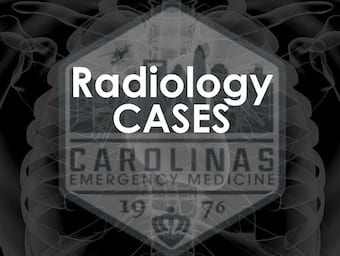
CT Case 069
A 70-year-old man presents with 3 days of abdominal pain and vomiting. He has had 15 vomits in the 24 hours prior to presentation

A 70-year-old man presents with 3 days of abdominal pain and vomiting. He has had 15 vomits in the 24 hours prior to presentation

A 60-year-old male is brought in by ambulance with fevers >40°C, rigors and confusion. He complains of a dental infection and associated facial swelling

80-year-old female presents with four days of left flank pain and fever. She is febrile 39.5, HR 110, and hypotensive with SBP 90. Blood results reveal an acute kidney injury with creatine 120 and lactate of 5 A Non-contrast CT…

A 71-year-old presents with vomiting and abdominal pain and inability to open his bowels. This was preceded by three days of diarrhoea.

A 70-year-old presents with flank pain 4 days after a renal biopsy for investigation of a renal mass. He has a previous history of bioprosthetic aortic valve and is on warfarin and aspirin.

A 70-year-old presents with flank pain 4 days after a renal biopsy for investigation of a renal mass. He has a previous history of bioprosthetic aortic valve and is on warfarin and aspirin.

A 86-year-old lady tripped over while walking, landing face first on the ground. She has sustained multiple abrasions to her face, an eyelid laceration and she has midline c-spine tenderness

A 65-year-old lady presents with abrupt onset of epigastric pain radiating to her back and right shoulder.

A 36-year-old female presents with sudden onset right sided facial drop, right hemiparesis and dysarthria.

May 2024 Implantable device imaging and interpretation. Ventriculoperitoneal (VP) shunts with Friedman, Patterson and Miller

Sternal fractures and dislocations. Adult Orthopedic case interpretation with Carrie Bissell, Aaron Fox, Stephanie Jensen, Kendrick Lim and Olivia Rice

Native Hip Dislocations. Adult Orthopedic case interpretation with Carrie Bissell, Ainsley Bloomer, Aaron Fox, Andrew Rees and Kendrick Lim